Abstract
Investigating crack evolution characteristics in expansive soil under dry–wet cycle conditions is essential for analyzing the shallow instability of embankments and roadbeds filled with this type of soil. Indoor tests on remolded expansive soil specimens were performed under dry–wet cycle conditions, and digital image processing technology (PCAS) was used to quantitatively analyze the process of crack evolution. The study examined how initial moisture content, compaction degree, thickness, and expansibility affect crack development in expansive soil. Additionally, the study discussed the mechanism of crack evolution, considering the characteristics of crack structures in expansive soil. The findings suggest that crack development in expansive soil specimens is influenced by various factors including initial moisture content, compaction degree, thickness, and expansibility. The crack ratio increases with the initial moisture content, thickness, and expansibility, but decreases with the compaction degree. Furthermore, a significant linear relationship exists between the attenuation rate of soil strength and the crack ratio. The development of cracks is governed by the variance in soil shrinkage, which leads to the formation of distinct shrinkage centers at various locations and is markedly influenced by the soil’s thickness. This research explores the laws governing the evolution of cracks in expansive soils, elucidating the mechanisms by which these cracks evolve under the influence of various factors. It addresses a significant gap in the theoretical understanding of crack evolution in expansive soils under conditions of multiple influences, thereby offering crucial insights into the characteristics of soil evolution.
1. Introduction
As a distinctive type of soil predominantly composed of clay minerals, expansive soil exhibits pronounced expansibility and strong hydrophilicity. Its volume deformation is highly sensitive to changes in moisture content [1,2,3]. Under the influence of wet–dry cycling, the moisture content in different depth zones of an expansive soil slope becomes unevenly distributed, leading to varying degrees of volume deformation and the development of cracks in shallow regions [4]. Subsequent rainfall further deepens these cracks, ultimately forming a complex network of cracks [5]. This adversely affects the slope’s infiltration capacity, compromises soil structure integrity, and ultimately diminishes slope stability [6,7]. Geological survey data indicate variations in initial moisture content, compaction degree, and thickness across different regions of the same slope surface due to the influence of slope structures and geometric shapes [5]. Consequently, even under identical rainfall conditions, significant differences in crack development can be expected among different regions of the expansive soil slope, leading to localized instability and deformation.
Current scholarly discourse on the mechanisms governing the evolution of cracks in expansive soils is predominantly centered on the frequency of wet–dry cycles [8,9,10,11,12]. Empirical evidence suggests a correlation between an increased number of these cycles and a more pronounced progression of soil cracking. Nonetheless, the existing body of research is characterized by a dearth of quantitative analyses pertaining to the developmental traits of these cracks. Specifically, there is a notable absence of detailed, quantitative assessments examining how intrinsic soil properties [13,14,15,16]—such as initial moisture levels, compaction, thickness [17], and soil density—affect the measurable progression of cracking. The majority of existing studies have isolated single factors for investigation, overlooking the fact that the evolution of soil cracks in expansive soils is a multifaceted phenomenon influenced by a confluence of factors. The current state of research, particularly in the context of wet–dry cycling, is superficial with respect to the multifactorial influences on crack evolution, and is further hampered by a paucity of theoretical underpinning. Consequently, a nuanced exploration of how cracks in expansive soils develop under the influence of wet–dry cycles is imperative. Such an inquiry should aim to elucidate the multifactorial dynamics of crack evolution and uncover the underlying mechanisms [18,19,20,21,22,23,24,25].
The study focuses on the reshaping of expansive soil in the Guangxi Zhuang Autonomous Region. Indoor basic physical property tests assist us in obtaining the soil’s basic performance indicators and conducting quantitative descriptions of crack development characteristics through digital image analysis processing techniques. Secondly, the evolutionary laws of crack development characteristics in expansive soil under various conditions, including different initial moisture contents, compaction degrees, and thickness, are analyzed based on indoor wet–dry cycle test results. Subsequently, soil mechanical property tests were conducted, focusing on the variation in shear strength indicators of expansive soil concerning the number of wet–dry cycles and crack ratio. Finally, the evolutionary mechanism of cracks in expansive soil under wet–dry cycle conditions is elucidated from the perspective of crack development characteristics.
2. Basic Physical Properties of Expansive Soil Samples
2.1. Experimental Materials
The expansive soil utilized in this study was sourced from the construction site of the Chong’ai Expressway (Section K23+800) in Ningming County, Chongzuo City, Guangxi Zhuang Autonomous Region (Figure 1). This particular construction section is notorious for its unfavorable geological conditions associated with expansive soil. To accurately represent the engineering conditions and geological findings, two sampling points were designated within the K23+800 road section. The soil samples were collected from the test points at a depth of 0.1–0.5 m. They had an initial moisture content of approximately 35% and an initial dry density ranging from 1.20 to 1.46 g/cm3.
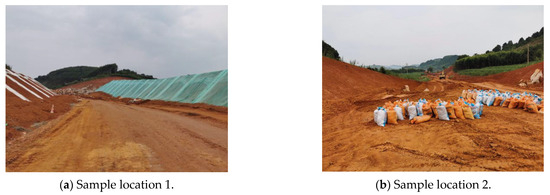
Figure 1.
Sampling Point at Section K23+800 on the Chong’ai Expressway.
2.2. Basic Physical Properties of Sample Materials
The construction of fill slopes significantly alters the soil’s original structure, resulting in a typical remolded soil. Consequently, this paper centers its investigation on the properties of remolded expansive soils. The fundamental physical properties at the sampling site were determined using standard geotechnical testing protocols [26]. The free swelling test outcomes indicate that the expansive soil sample from sampling point 1 exhibits a swelling rate of 98%, whereas the sample from point 2 shows a rate of 75%. Based on the classification criteria for expansive soils, those with a swelling rate exceeding 90% are designated as highly expansive, whereas those below this threshold are categorized as moderately expansive. Consequently, the soil at sampling point 1 is designated as highly expansive, and that at point 2 as moderately expansive. The physical and mechanical properties of the undisturbed expansive soil are detailed in Table 1.

Table 1.
Basic physical properties of the tested expansive soil samples.
Smectite, illite, and kaolinite, among other secondary minerals, are formed through chemical weathering. These fine mineral particles are the primary constituents of clay minerals and significantly influence the engineering properties of soil. Utilizing a Smart-lab XRD analyzer, X-ray diffraction analysis was performed on samples of highly expansive soil, as depicted in Figure 2. The findings indicate that quartz, smectite, illite, kaolinite, and trace amounts of calcite are the predominant minerals, with clay minerals comprising a substantial fraction. Smectite exhibits the highest hydrophilicity, capable of absorbing substantial water molecules within its interlayers. Illite, with a crystalline lattice and interlayer structure akin to smectite, is less hydrophilic. Kaolinite’s strong interlayer bonding impedes water molecule penetration, resulting in lower hydrophilicity compared to illite. Consequently, the concentration of smectite and illite is notably elevated in highly expansive soil and rock. The clay mineral’s structural unit in expansive soil is composed of two SiO2 layers and one Al2O3 layer. The weak interlayer bonding facilitates rapid water molecule infiltration, leading to internal crystal lattice expansion and subsequent rapid disintegration of the soil, which is a key mechanism in the development and progression of fissures.
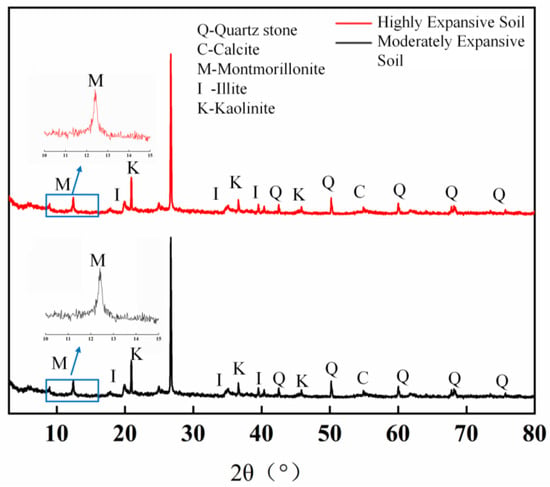
Figure 2.
X-ray diffraction spectrum of expansive soil in its initial state.
3. Indoor Wet–Dry Cycle Test of Expansive Soil
3.1. Sample Preparation and Testing Methods
(1) Sample preparation
In the domain of geotechnical engineering, the ring shear specimen stands out as the preeminent choice for testing due to its straightforward preparation and the availability of diverse testing and detection apparatus. Consequently, the current study employs ring shear samples for the indoor wet–dry cycle experiments on expansive soils, which are specified to have a diameter of 61.8 mm. The thickness of these samples is determined based on the stipulations of the experimental protocol. Two types of expansive soil samples were used in the test: medium-expansivity soil and strong-expansivity soil. The initial dry density of the strong-expansivity soil sample is 1.2 g/cm3, with an initial saturation of 48.7%. The medium-expansivity soil sample has an initial dry density of 1.4 g/cm3 and an initial saturation of 46.4%. The reconstituted expansive soil ring knife samples were prepared as follows:
- 1.
- Start by drying the expansive soil samples obtained from the sampling point in an oven;
- 2.
- After drying, crush the soil samples using a soil crusher and pass them through a 1 mm sieve;
- 3.
- Transfer the crushed and sieved expansive soil into a plastic bag and calculate the required amount of water based on the initial moisture content specified in the test design;
- 4.
- As per the experimental specifications, uniformly distribute the dried expanded soil onto the container tray. Apply Vaseline to the basin of the stainless steel container to prevent it from constraining crack development at the bottom of the test block. Then, gradually and uniformly add water using a small spray bottle until reaching the predetermined value, ensuring thorough mixing with the soil. Following configuration, seal the sample in a plastic bag for 48 h to guarantee consistent moisture distribution, as depicted in Figure 3;
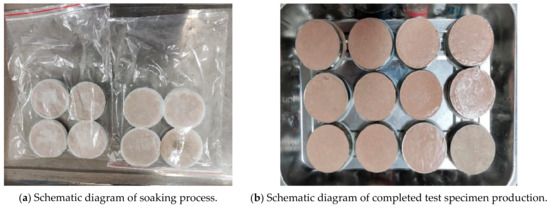 Figure 3. Process of expansive soil sample preparation.
Figure 3. Process of expansive soil sample preparation. - 5.
- Once the soaking process is complete, take an appropriate amount of soil sample and pour it into the ring knife. Compact it with a weight and prepare the expansive soil ring knife samples with different compaction degrees and thicknesses according to the test design plan.
(2) Experimental design and methodology
The objective of this section is to investigate the characteristics of crack development in expansive soil samples under wet–dry cycles, taking into account different initial moisture contents, compaction degrees, and thicknesses. Table 2 presents the physical parameters of the expansive soil samples under various influencing factors. The compaction degree of the expansive soil subgrade is typically maintained between 90% and 96% to ensure safe and comfortable driving conditions. However, achieving a compaction degree of over 90% under high-moisture-content conditions is challenging. Therefore, for the indoor wet–dry cycle test in this study, compaction degrees of 80% and 90% were chosen. Given that shallow instability predominantly contributes to the instability of expansive soil slopes, especially during periods of rainfall when the soil in these shallow slopes tends to be saturated, expansive soil specimens are saturated using a vacuum saturation apparatus.

Table 2.
Basic information of the dry–wet cycling test samples.
The specific steps of the wet–dry cycle test are as follows: First, the expansive soil samples sealed in plastic bags are placed in a constant temperature oven for drying. The oven temperature is set to 35 °C based on the meteorological data of the soil collection site on the Chong’ai Expressway in Guangxi. Regularly measure the samples’ weight to determine changes in moisture content. Considering that the shrinkage limit moisture content of the expansive soil specimens employed in this study is 12%, further data recording ceases once the moisture content falls below this threshold. Consequently, soil shrinkage becomes notably challenging at this juncture, with crack formation essentially halting, marking the conclusion of a single dry cycle process. Subsequently, utilize a digital camera to capture photographs of the samples’ surface and sides. Then, reassemble the samples within a ring cutter, with permeable paper and a 5 mm-thick permeable stone placed both above and below the samples. Secure the assembly using a G-clamp and subsequently subject it to saturation by placing it in a vacuum saturation device. Finally, after maintaining the samples under constant conditions for 24 h and completing the saturation process, remove them and position them back in the drying oven. Capture additional photographs when the moisture content reaches approximately 12%, marking the beginning of the second dry–wet cycle. Repeat these steps for the third to fifth dry–wet cycles. Ultimately, the diagram depicting the change in crack morphology, as illustrated in Figure 4, is acquired.

Figure 4.
Crack morphology variation during wet–dry cycling process.
(3) Crack image processing
Digital imaging was employed to quantitatively characterize the development of cracks in expansive soil specimens. The specific procedure is outlined as follows:
- 1.
- Initially, the RGB color image was grayscaled using Photoshop software (V13.0.1.3), with the grayscale value typically set to 0 or 255;
- 2.
- Subsequently, the grayscale image was imported into PCAS crack image analysis and processing software for binary image processing (Figure 5c);
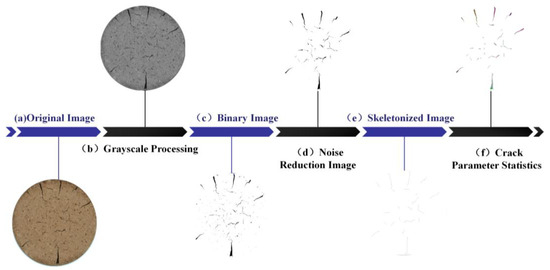 Figure 5. Fracture image processing process.
Figure 5. Fracture image processing process. - 3.
- The denoising function of the PCAS software (V2.3) was then utilized to remove noise from the binary image (Figure 5d);
- 4.
- Subsequently, crack skeletonization processing was performed (Figure 5e).
The crack ratio represents the aggregate of crack areas per unit area of soil [27], determined through image processing. Specifically, it denotes the ratio of black cracks in binarized images of expansive soil samples to the entire image. The precise calculation formula is presented below:
In the equations, Ai and A denote the area of the ith crack and the sample area, respectively, while nb and nw represent the counts of black and white pixels, and n signifies the total number of pixels.
During crack length computation, the software automatically categorizes cracks into three groups—horizontal, vertical, and diagonal lines, with horizontal and vertical lines standardized to a length of 1 unit each, and diagonal lines treated as individual units. Subsequently, upon gathering and categorizing all cracks within the image, the lengths of the three types of cracks are summed to determine the total crack length.
The average width of cracks is represented by the ratio of the total crack area to the total crack length. The specific calculation is as follows:
In the equation above, li denotes the length of the ith crack, while the remaining parameters carry the same significance as in Equation (1).
3.2. Experimental Results and Analysis
(1) The Influence of Dry–Wet Cycle Number on Crack Development Characteristics
Expansive soil exhibits significant shrinkage and swelling effects during repeated cycles of water absorption and loss, resulting in noticeable volume changes and the continuous extension of cracks on the soil surface due to uneven deformation. For this experiment, a total of five dry–wet cycles were performed to examine the changes in fundamental crack characteristics in samples of moderately to highly expansive soil. Taking the crack development characteristics of samples of medium to highly expansive soil with 35% initial moisture content and an 80% compaction degree as examples, the influence of the dry–wet cycle number on crack development characteristics in expansive soil has been analyzed.
Figure 6a shows the variation curve of the ratio of crack area to sample area in samples of medium to highly expansive soil with respect to the dry–wet cycle number. The results indicate that, for different types of expansive soil, the crack ratio initially increases and then reaches stability with an increasing number of dry–wet cycles. After the first cycle, the crack ratios for the samples of medium and highly expansive soil are only 0.7% and 0.8%, respectively, indicating the absence of observable cracks or damage on the soil surface during the initial cycle. After the second cycle, the crack ratio for the samples of medium and highly expansive soil rapidly rises to 3.8% and 4.5%, respectively. Following the fifth dry–wet cycle, the crack ratios for the samples of medium expansive soils reach 4.6%, representing a 20% increase compared to the end of the second cycle. In contrast, the crack ratio for the samples of highly expansive soil exhibits a more pronounced response to the dry–wet cycle number, reaching 6.08% after the fifth cycle, which corresponds to a 35.9% increase compared to the end of the second cycle. Compared to the highly expansive soil samples, crack development in the medium expansive soil is less sensitive to the dry–wet cycle number, indicating that the influence of cycle number on crack development gradually diminishes after the third cycle. Under the same cycle conditions, the crack ratio for the highly expansive soil continues to increase in subsequent cycles, but with a decreasing rate.
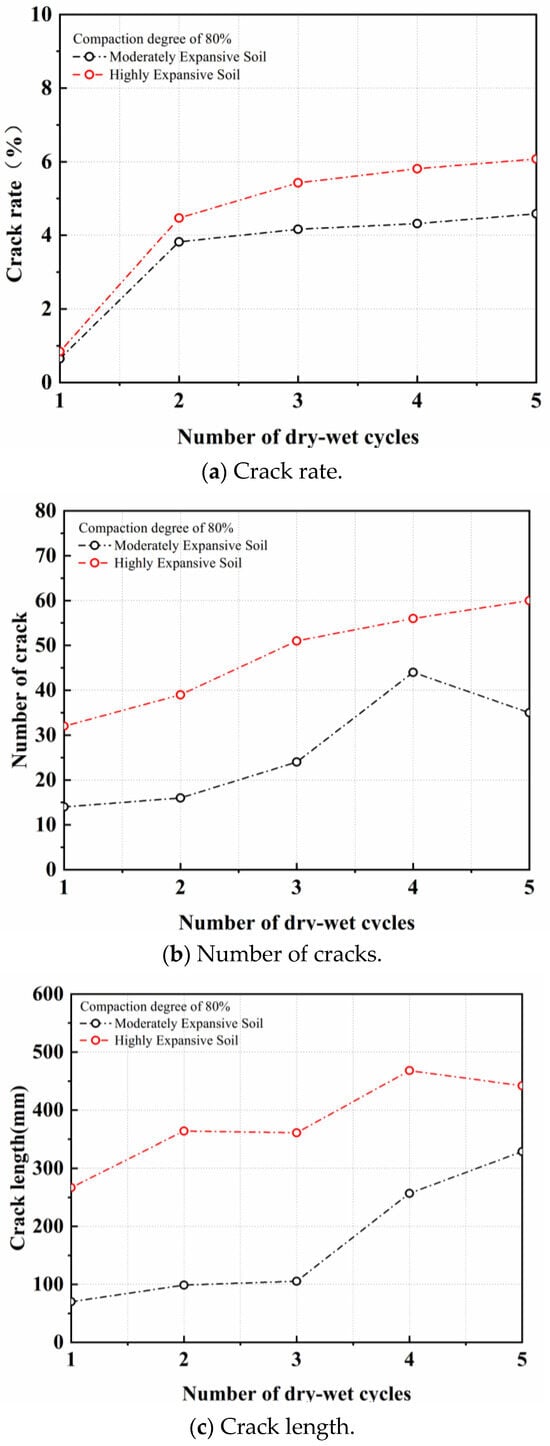
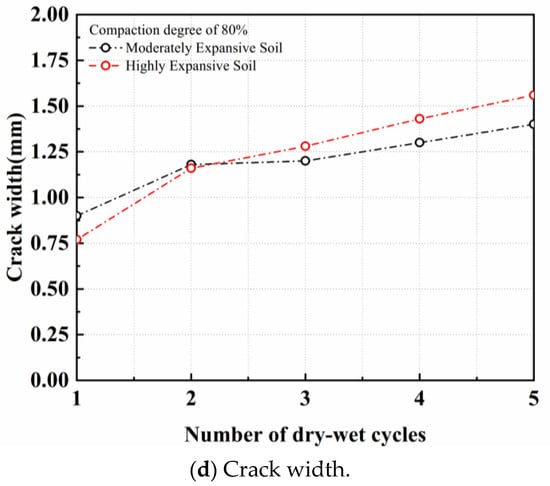
Figure 6.
Variation curves of basic morphological parameters of cracks in expansive soil under different dry–wet cycle numbers.
Since the crack ratio represents the ratio of total crack area to sample area, it can yield the same result for different combinations of crack numbers, lengths, and widths. Therefore, the variations of the total crack numbers, lengths, and average widths on the soil surface in samples of medium to highly expansive soil under different dry–wet cycle numbers were monitored and analyzed. Figure 6b shows the variation curves of the total crack numbers in medium to highly expansive soil samples with respect to the dry–wet cycle number. The results demonstrate that the surface crack numbers of the medium expansive soil samples remain stable after the first and second cycles, then increase rapidly to 44 after the fourth cycle and decrease to 35 after the fifth dry–wet cycle. In contrast, the highly expansive soil samples accumulate 32 cracks after the initial dry–wet cycle, which number steadily increases with the cycle number, reaching 60 by the end of the fifth cycle. Figure 6c presents the variation curves of the total crack lengths on the soil surface in samples of medium to highly expansive soil with respect to the dry–wet cycle number. The results show an overall increasing trend in the total length of cracks on the soil surface with the dry–wet cycle number. Specifically, the total crack length of the medium expansive soil samples rapidly increases after the third cycle, rising from 99.9 mm to 290 mm after the fifth cycle. In contrast, the total crack length of the highly expansive soil samples remains relatively constant after the second and third cycles, but continues to increase in subsequent dry–wet cycles, reaching 442 mm. Figure 6d shows the variation curve of the average crack width on the soil surface in samples of medium to highly expansive soil with respect to the dry–wet cycle number. The results demonstrate that the average crack width increases with an increasing number of dry–wet cycles in both the medium and highly expansive soil samples. Specifically, the average crack width of the medium expansive soil samples increases from 0.9 mm to 1.4 mm, while the average crack width of the highly expansive soil samples increases from 0.8 mm to 1.6 mm. This phenomenon indicates that cracks on the sample surface expand continuously as a result of repeated tension and healing during the drying–shrinkage–wetting–expansion process, leading to an increasing width of surface cracks as the cracks extend deeper.
Based on the evolution of the cracks’ basic morphological parameters with the number of dry–wet cycles, it is evident that the crack ratio of the expansive soil tends to stabilize as the number of dry–wet cycles increases. This observation suggests that the degree of crack development in the soil gradually decreases under the influence of moisture variations following multiple dry–wet cycles. During the heating and dehydration process of the samples, the surface soil loses water at a significantly faster rate than the interior soil, resulting in notable moisture content gradients across different parts of the samples. Consequently, this lack of coordination or constraint in the deformation between the surface and interior soil generates corresponding tensile stresses within the soil. If the tensile strength provided by the soil is smaller than the tensile stress caused by moisture loss, stress concentration is released in the surrounding area of the developing crack, leading to the occurrence of tensile cracks in the expansive soil. The repeated process of cracking–closing–cracking during multiple dry–wet cycles causes the crack to continuously expand, ultimately resulting in the formation of interconnected multiple cracks. At this point, the sample has been completely fragmented into different-sized soil blocks, and the influence of dry–wet cycles on the development of cracks in the expansive soil gradually weakens. This observation aligns with the trend demonstrated by the experimental results, where the total number of cracks, total length, and width increases with the number of dry–wet cycles.
(2) The Impact of Initial Moisture Content on Crack Development Characteristics
Figure 7 presents the variation curves of basic crack parameters of expansive soil specimens with different initial moisture contents under different dry–wet cycling conditions. As shown in Figure 7a, the crack ratios of different initial moisture content expansive soil specimens show an increasing trend followed by stabilization with the increase in dry–wet cycling times. The crack ratio of medium-expansion soil specimens exhibits obvious differences under different initial moisture content conditions, increasing with the increase in initial moisture content. After the first dry–wet cycle, the crack ratio of medium-expansion soil specimens with an initial moisture content of 30% is only 52.9% of that with an initial moisture content of 40%. With the increase in dry–wet cycling times, the difference between the two gradually decreases. After the fifth dry–wet cycle, the crack ratio of the latter only increases by 16% compared to the former. For high-expansion soil, the influences of different initial moisture contents on the crack ratios of specimens are relatively complex. Among them, the crack ratio variation curves of high-expansion soil specimens with an initial moisture content of 30% and 35% almost overlap, while the crack ratios of specimens with an initial moisture content of 40% significantly increase compared to the former two. This phenomenon indicates that the influence of initial moisture content on the crack ratio of expansive soil under multiple dry–wet cycling conditions is affected by its own expansibility. For medium-expansion soil, an increase in initial moisture content will enhance the soil’s shrinkage and swelling characteristics. In contrast, for high-expansion soil, the influence of initial moisture content on its shrinkage and swelling characteristics can only be observed when the initial moisture content is above 35%.
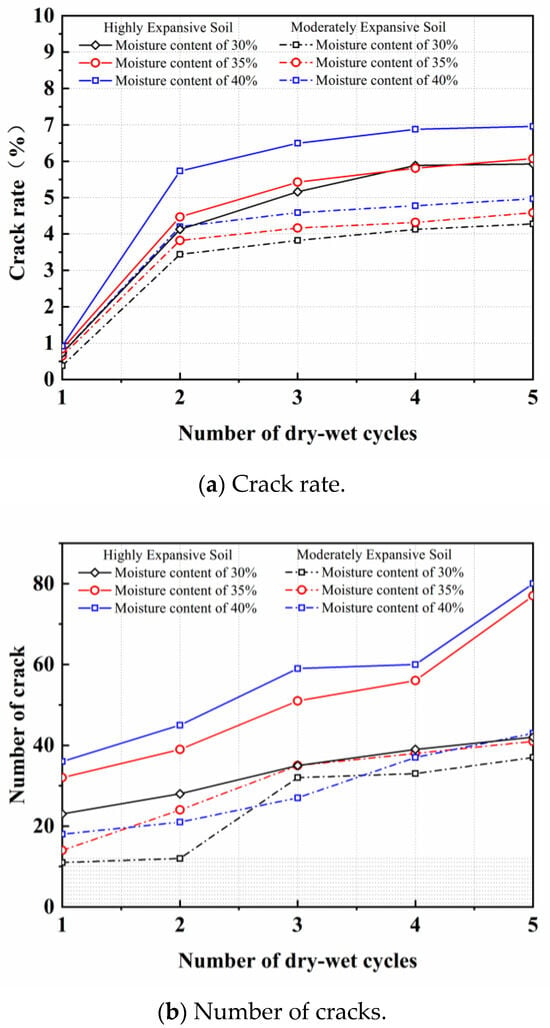
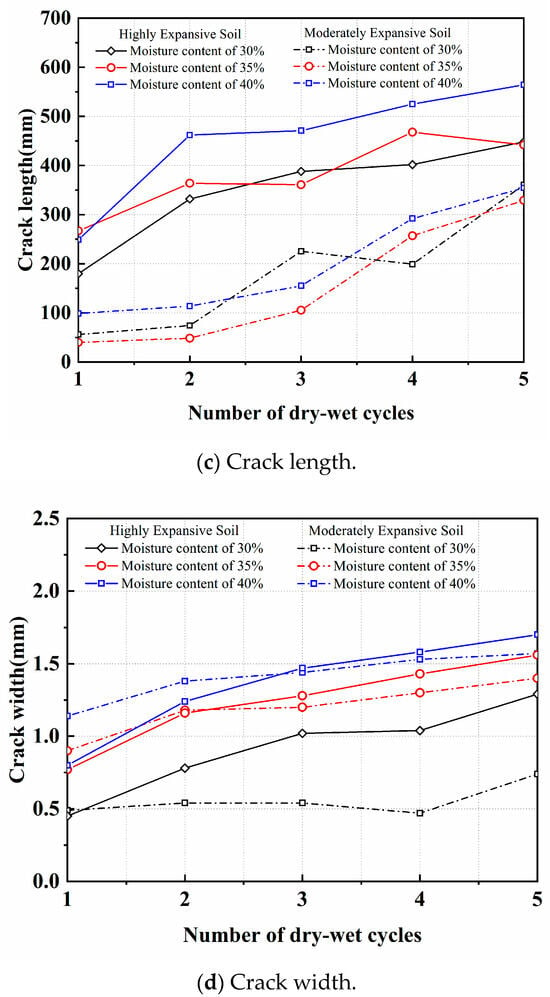
Figure 7.
Variation curves of basic morphological parameters of cracks in expansive soil under different initial moisture content conditions.
Figure 7b shows the variation curves of the total number of cracks of different initial moisture content expansive soil specimens under different dry–wet cycling conditions. The total number of cracks of both medium- and high-expansion soil specimens increases with the increase in dry–wet cycling times. Among them, the total number of cracks in medium-expansion soil specimens is not strongly correlated with the initial moisture content, and the total number of cracks is basically the same under different initial moisture content conditions. The total number of cracks in high-expansion soil specimens is more sensitive to changes in initial moisture content. After the first dry–wet cycle, the total number of cracks in high-expansion soil specimens with initial moisture contents of 30% and 40% are 23 and 36, respectively. After the fifth dry–wet cycle, the total numbers of cracks in the two specimens become 42 and 80. This phenomenon indicates that the higher the initial moisture content, the greater the total number of cracks, and the difference in the total number of cracks becomes more significant with the increase in cycling times.
Figure 7c shows the variation curve of the total length of cracks of different initial moisture content expansive soil specimens under different dry–wet cycling conditions. The total length of cracks in both medium- and high-expansion soil specimens generally increases with the increase in initial moisture content. The difference in the influence of initial moisture content on the total length of cracks in medium-expansion soil specimens gradually decreases with the increase in dry–wet cycling times. The total lengths of cracks in high-expansion soil specimens under initial moisture content conditions of 35% and 30% are relatively similar, and tend to stabilize after the second dry–wet cycle. The total length of cracks in high-expansion soil specimens with an initial moisture content of 40% is significantly higher compared to the other two groups of specimens, and continues to increase with the increase in dry–wet cycling times. Figure 7d shows the variation curve of the average width of cracks of different initial moisture content expansive soil specimens under different dry–wet cycling conditions. The results indicate that the average width of cracks in expansive soil specimens is significantly influenced by the initial moisture content. When the initial moisture content is higher than 35%, the average width of cracks is significantly increased compared to specimens with an initial moisture content of 30%. The average width of cracks in high-expansion soil specimens is more sensitive to changes in dry–wet cycling times, and shows an overall increasing trend. Under multiple dry–wet cycling conditions, the average width of cracks in medium-expansion soil specimens changes relatively less, especially for specimens with an initial moisture content of 30%, maintaining a range of 0.47–0.74 mm.
Based on the evolution of basic crack parameters of medium- and high-expansion soil specimens with different initial moisture contents under multiple dry–wet cycling conditions, it can be concluded that as the initial moisture content decreases, the crack distribution of specimens tends to become simpler, and the crack ratio, quantity, and geometric dimensions decrease. From a microscopic perspective, the binding water film between clay particles in expansive soil with a higher initial moisture content is relatively thick, and the free water content increases. During the dehydration process, more significant water loss occurs, resulting in volume shrinkage. From a macroscopic perspective, in the process of crack development caused by the dehydration of expansive soil, the increase in initial moisture content directly leads to a larger gradient difference between the surface area and the internal moisture content after water loss. This leads to more significant uneven shrinkage and confinement in the depth direction, accelerates crack development and extension, and causes more obvious crack damage in specimens. This result is consistent with previous research findings.
(3) The effect of compaction level on crack development characteristics
Figure 8 illustrates the variation curves of the fundamental crack morphological parameters of various compacted expansive soil specimens under different dry–wet cycling conditions. The figure indicates that increased compactness leads to a decrease in the crack ratio, total crack count, total crack length, and average crack width of the expansive soil specimens. Additionally, the range of variation in the basic crack morphological parameters decreases with increasing compactness under multiple dry–wet cycles, suggesting that compactness imposes restrictions on the shrinkage and swelling characteristics of the expansive soil (Figure 8a). For example, the crack ratio difference between specimens with 90% and 80% compactness ranges from 0.23% to 0.61%. This influence of compactness on the crack ratio is most noticeable in highly expansive soil samples, with crack ratios after the second dry–wet cycle reaching 4.47% and 3.33%, respectively, for specimens with 80% and 90% compactness, indicating a difference of over 1%. Furthermore, the impacts of different compactness levels on the crack ratio stabilize as the number of dry–wet cycles increases, primarily due to the self-expansive nature of the soil samples.
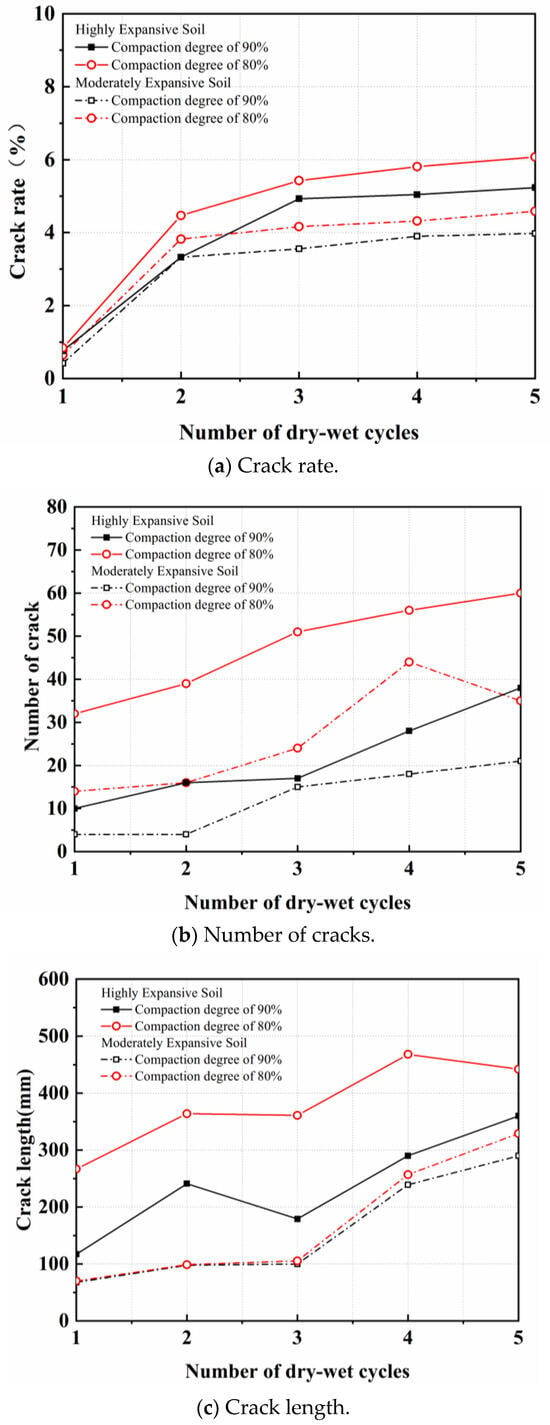
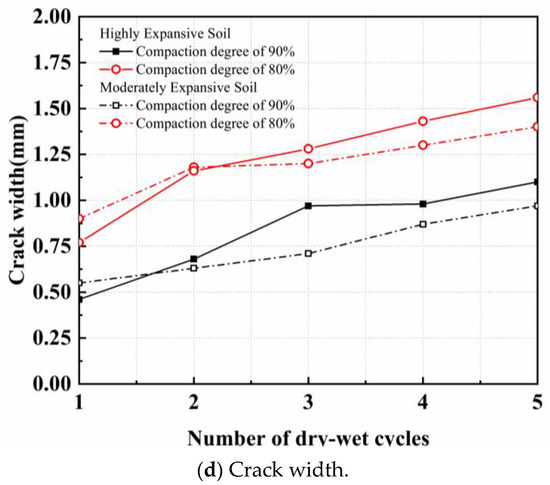
Figure 8.
Variation curves of basic morphological parameters of expansive soil cracks under different compaction conditions.
Figure 8b demonstrates the variation curves of the total crack counts of different compacted expansive soil specimens with the number of dry–wet cycles. Unlike the crack ratio, compactness significantly influences the total crack count. In comparison to the specimen with 80% compactness, taken as the reference value, increasing compactness by 10% results in a reduction in the total crack count of moderately expansive soil samples varying from 37.5% to 71.4%, and the decrease is from 36.7% to 68.8% for highly expansive soil samples. With 80% compactness, the total crack count generally increases with the number of dry–wet cycles for moderately and highly expansive soil samples. In contrast, the variation in total crack count of specimens with 90% compactness after the first and second dry–wet cycles is insignificant, indicating that increasing compactness limits the generation and extension of cracks in the expansive soil samples (Figure 8c). The total crack length of moderately expansive soil samples is minimally affected by compactness, with noticeable differences observed only after multiple dry–wet cycles. In contrast, the total crack length of highly expansive soil doubles under 80% compactness compared to 90% compactness. The number of dry–wet cycles affects the average crack width of the soil samples in relation to compactness. The crack width of the 80% compactness specimen is significantly higher than that of the 90% compactness specimen, with the former being more than 1.5 times higher. As the number of dry–wet cycles increases, the difference in average crack width between the two specimens gradually grows, indicating that decreased compactness intensifies the enhancement of the shrinkage and swelling characteristics of the expansive soil during multiple water absorption and desorption processes.
During the preparation of expansive soil samples with varying compaction levels, increased compaction results in the greater fragmentation of larger soil particles, thereby compromising the soil’s structural integrity. The resultant fine particles from this fragmentation efficiently fill soil pores, thereby diminishing the sample’s porosity. Microscopically, this reduction in porosity constricts the pathways for free water flow within the soil, curtailing the capacity for volumetric expansion. Macroscopically, the lowered porosity impedes water infiltration during absorption and wet cycling, thereby dampening the soil’s propensity to absorb water and swell. Additionally, it diminishes the gradient in moisture content from the sample’s surface to its core, leading to a more uniform distribution of tensile stresses throughout the soil mass. This uniformity in stress distribution, in turn, restricts the propagation and expansion of cracks.
(4) The impact of thickness on the characteristics of crack development
To investigate the effect of thickness on crack development in expansive soil, specimens of medium and highly expansive soil were prepared with thicknesses of 1 cm, 2 cm, 3 cm, and 4 cm. The crack development characteristics of the specimens were analyzed after multiple dry–wet cycles. Figure 9 illustrates the curves of the basic morphological parameters of the cracks.
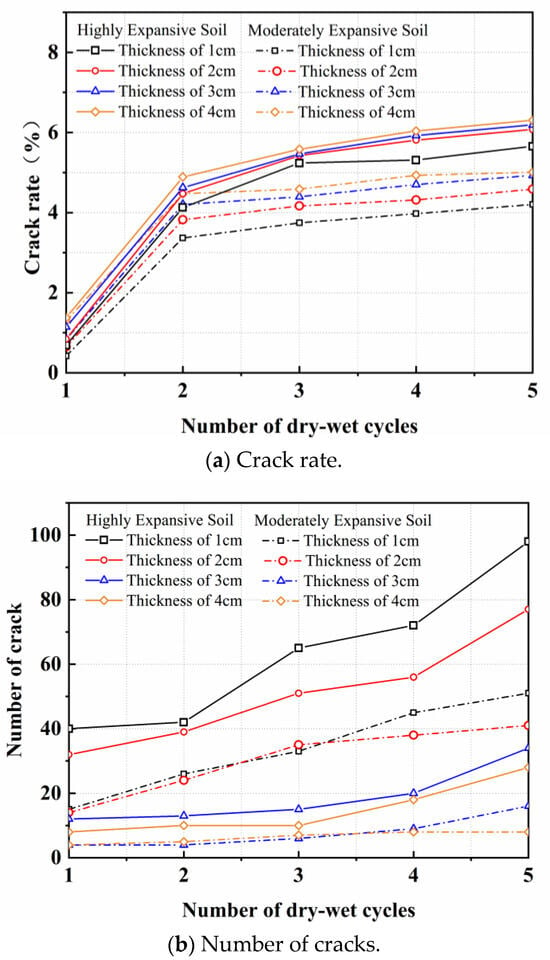
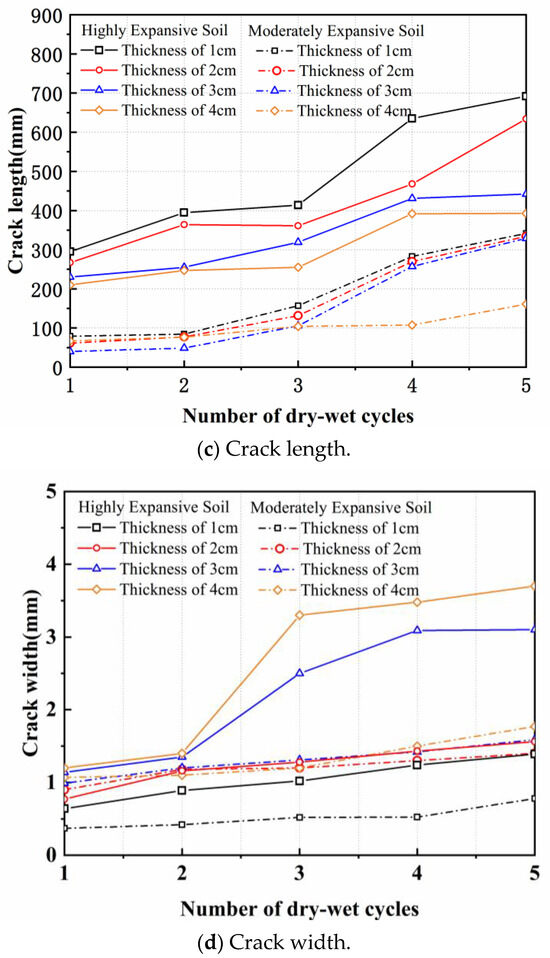
Figure 9.
Variation curve of basic morphological parameters of expansion soil cracks under different thickness conditions.
Figure 9a displays the crack ratio variation with the number of dry–wet cycles for different thicknesses of expansive soil specimens. The results demonstrate that thicker specimens exhibit higher crack ratios. The influence of thickness on the crack ratio is relatively small under different dry–wet cycle conditions. The crack ratio of the highly expansive soil specimens remains between 5.65% and 6.3%, while for the medium expansive soil specimens, it ranges from 4.2% to 5%. After five dry–wet cycles, the final crack ratio of the 4 cm-thick specimens is 6.3% (for the highly expansive soil) and 5% (for the medium expansive soil). In contrast, the final crack ratio of the 1 cm-thick specimens is 5.65% (for the highly expansive soil) and 4.2% (for the medium expansive soil). This represents an increase of 10.3% and 16% in crack ratio, respectively. The crack ratio represents the ratio of the crack area to the total area of the specimen. Analyses of experimental data reveal that thickness does influence the development of cracks in expansive soil; however, the exact nature and extent of this influence are not readily apparent. This phenomenon is primarily attributed to the specimen size effect and the imposed maximum thickness of 4 cm under experimental conditions.
Figure 9b,c depict the variations of total crack length and total number of cracks with the number of dry–wet cycles for different thicknesses. The results indicate that, with increasing thickness, the total crack length decreases while the total number of cracks increases. The final total crack lengths of the 1 cm-thick specimens of medium and highly expansive soil are 341.4 mm and 634 mm, respectively. On the other hand, the final total crack lengths of the 4 cm-thick specimens of medium and highly expansive soil are 160.8 mm and 193 mm, respectively. The final total numbers of cracks in the 1 cm-thick specimens of medium and highly expansive soil are 51 and 98, respectively. In contrast, the final total numbers of cracks for the 4 cm-thick specimens of medium and highly expansive soils are 8 and 28, respectively. This phenomenon suggests that samples with smaller thickness have more divided soil blocks and larger total crack lengths during the dry–wet cycle process.
Figure 9d shows the variation in average crack width with the number of dry–wet cycles for different specimen thicknesses. The average crack width reflects the extent of crack opening in expansive soil during the influence of dry–wet cycles. The curve demonstrates that the crack width increases with increased thickness. The average crack widths of the 4 cm-thick specimens of medium and highly expansive soil are 1.77 mm and 3.7 mm, respectively. In contrast, the average crack widths of the 1 cm-thick specimens of medium and highly expansive soil are only 0.78 mm and 1.39 mm, respectively. There are significant differences in average crack width among different thicknesses. This phenomenon indicates that thickness noticeably influences the width development of cracks in expansive soil, with an increase in thickness promoting crack widening.
The influence of specimen thickness on the crack development characteristics of expansive soil samples is relatively complex. Generally, an increase in thickness leads to a decrease in the total number and length of cracks, while the crack ratio and average crack width of the specimens increase. With an increase in specimen thickness, the influences of boundary effects on volume deformation become more apparent. The water loss shrinkage process mainly occurs at the surface of the specimens, and thicker specimens face more difficulty in evaporating moisture, which inhibits crack development and expansion to some extent. Meanwhile, existing cracks provide fast flow channels for rainwater infiltration and evaporation, and the repeated dry–wet cycles further intensify the transverse expansion of cracks, resulting in an upward trend in average crack width with increased specimen thickness.
Analysis indicates that the initial moisture content, compaction level, and thickness significantly affect the development of cracks in expansive soil. Higher initial moisture content, lower compaction, and reduced thickness correlate with enhanced crack development, aligning with previous studies [11,12,21]. This research further explores the intricate evolution of cracks under the influence of multiple factors (initial water content, thickness, compaction degree, and the number of different wet–dry cycles) during repetitive wet–dry cycles, revealing a more complex pattern of crack progression.
4. Experimental Study on Mechanical Properties of Expansive Soil under Wetting–Drying Cycles
4.1. Sample Design and Method
Based on the results of the wet–dry cycle experiments conducted on expansive soil, medium and highly expansive soil samples were selected. These samples had a compaction degree of 90% and initial water content of 35% and 40%, respectively. A ZJ-type four-joint strain-controlled direct shear test device was utilized to conduct quick shear tests under different wet–dry cycling conditions, with a shear rate of 0.8 mm/min. Previous studies indicate that the shear strength test results of expansive soil under high normal stress conditions tend to be higher. For the case of instability in expansive soil slopes, it can be concluded that the failure mode is mostly shallow landslides, and the force acting on the slip surface generally falls within the range of 50 kPa. Therefore, in the experiments, normal stresses of 5 kPa, 10 kPa, 30 kPa, and 50 kPa were applied to each group of specimens, respectively.
During the experiment, the expansive soil specimens, subjected to different numbers of wet–dry cycles, were placed in a vacuum saturation apparatus. After being saturated for 24 h, the specimens were considered fully saturated, and were then transferred to the direct shear test apparatus for shear tests. The experiment aimed to determine the attenuation law of strength parameters of expansive soil under different wet–dry cycling conditions, as well as establish a quantitative relationship between shear strength indicators and crack quantification indicators for different normal stress and wet–dry cycle numbers. These data will serve as a reference for understanding the instability mechanism of expansive soil slopes under wet–dry cycling conditions.
4.2. Experimental Results and Analysis
Figure 10 presents the variation curves depicting the cohesive strength (c) and internal friction angle (φ) of expansive soil specimens with different initial water contents subjected to dry–wet cycles. As the number of dry–wet cycles increases, the cohesive strength of the expansive soil demonstrates a significant nonlinear decrease. For instance, considering a moderately expansive soil specimen with an initial water content of 35%, the cohesive strength decreases from the initial value of 41.2 kPa to 20.3 kPa after the fifth cycle, representing a 50% reduction. In contrast, a strongly expansive soil specimen with the same initial water content of 35% exhibits a relatively lower cohesive strength of 5.45 kPa, which corresponds to approximately 30% of its initial value. Conversely, the internal friction angle of the expansive soil shows a relatively low sensitivity to dry–wet cycles. The internal friction angle of the moderately expansive soil specimen decreases steadily as the number of dry–wet cycles increases, reaching its minimum value of 33.5° after the third cycle. In comparison, the internal friction angle of the strongly expansive soil specimen remains relatively constant, ranging between 26.6° and 30.1° (Figure 10b).
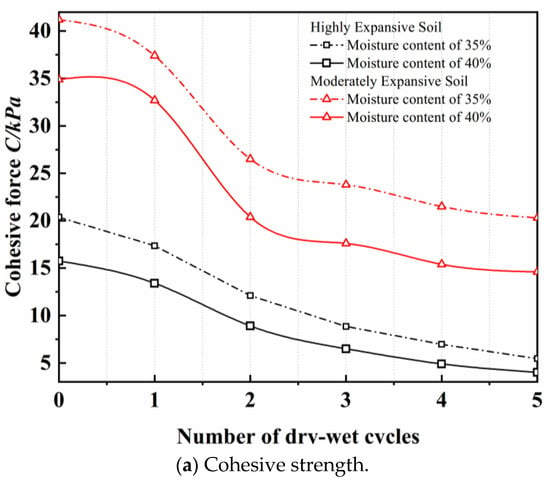
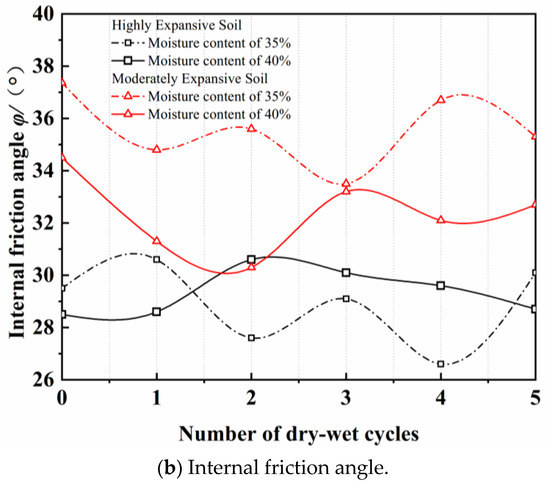
Figure 10.
Variation curve of shear strength index of expansive soil under different drying and wetting cycles.
The influence of the initial moisture content on the strength degradation of expansive soil is of significance. To quantitatively describe the degradation law of strength parameters for varying initial moisture contents, the cohesion index of the initial state of the expansive soil sample is used as the baseline. The cohesion degradation rate index is determined by calculating the ratio of the difference between cohesion after cyclic wetting and drying to the baseline value. Figure 11 presents the variation curve of the cohesion degradation rate for strongly expansive soil under different numbers of cyclic wetting and drying and different initial moisture contents. The results indicate that increasing the initial moisture content enhances the degree of cohesion degradation for both medium and strong expansive soil samples. After five cycles of wetting and drying, the cohesion of the medium expansive soil sample with an initial moisture content of 40% decreased from 34.9 kPa to 14.6 kPa, corresponding to a decrease of 58.2%. However, under the same conditions, the cohesion of the medium expansive soil sample with an initial moisture content of 35% only decreased by 50.7%. With an increase in soil expansiveness, the influence of initial moisture content on strength degradation gradually diminishes.
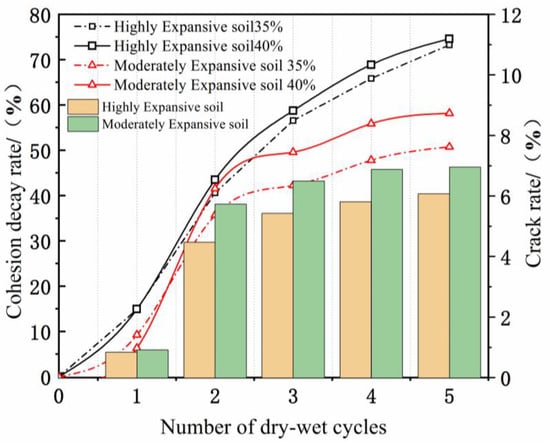
Figure 11.
Shear strength decay rate curve of expansive soil under different wetting and drying cycles.
Based on the results of indoor wetting–drying cycle tests on expansive soil, cracks of varying numbers and widths are observed on the surfaces of medium and highly expansive soil samples during the cyclic drying–wetting process. These cracks continuously expand and connect, resulting in alterations to the soil structure and leading to strength degradation. Thus, the strength degradation exhibited by expansive soil during the wetting–drying cycle can be seen as the mechanical response of the soil to the volumetric deformation caused by drying shrinkage and wetting expansion. This section aims to establish a link between the development characteristics of cracks in expansive soil and strength indicators, providing a deeper understanding of the influence of crack evolution on soil strength under wetting–drying cycle conditions. This serves as an important foundation for using crack indicators to predict changes in soil strength, and offers practical assistance for engineering applications. According to the distribution characteristics of crack ratio and cohesion decay ratio during different wetting–drying cycle processes, depicted in Figure 11, the strength degradation process of expansive soil can be approximately divided into three stages:
(1) The first stage (0–1 cycle) is characterized by the incubation period of cracks, with low crack development, high soil integrity, and minimal decay of cohesion;
(2) The second stage (1–4 cycles) shows the rapid development of cracks in the soil, leading to an increase in cohesion decay. The slope of the curve steepens, and by the end of the fourth cycle, cohesion decay reaches approximately 50%–70%;
(3) The third stage (4–5 cycles) indicates a stable development of cracks in the soil, with the decay process of cohesion gradually slowing down, and the slope of the curve becoming stable. This finding further confirms the close correlation between the strength degradation of expansive soil under wetting–drying cycle conditions and the development characteristics of cracks in the specimens. Thus, when dealing with slope prevention and control in expansive soil, it is necessary to employ support measures to mitigate the impact of natural forces on swelling and shrinkage deformation in slopes, consequently improving slope stability.
To gain further insights into the relationship between crack development and strength degradation in expansive soil, a linear fit is conducted to determine the decaying rate of cohesion for different crack ratios of expansive soil. The crack ratio of expansive soil is the primary quantitative evaluation parameter used to measure the cracking process of expansive soil. This parameter provides an accurate representation of the development and expansion process of micro and main cracks in the soil. The fitting results, as demonstrated in Figure 12, indicate a clear linear increase (R2 > 0.91) in the decay rate of cohesion with the rise in crack ratio for expansive soil. This suggests that the degradation of strength in expansive soil is primarily attributed to the damage inflicted on the soil structure due to the development of cracks in the specimens. Using crack ratio as a controlling indicator to depict the degradation law of expansive soil strength under wetting–drying cycle conditions is reasonably justified.
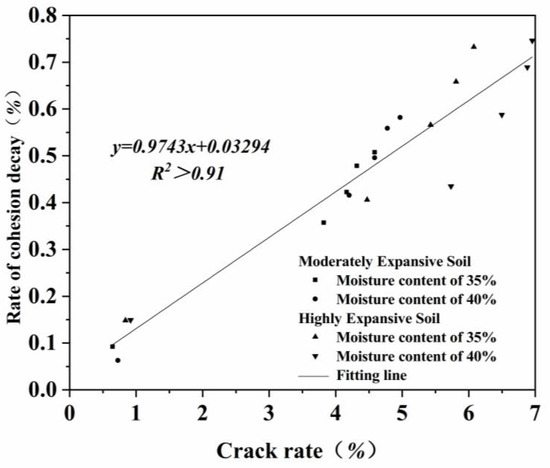
Figure 12.
Fitting line of the decrease rate of cohesive strength in expansive soil with crack surface area ratio.
5. Analyzing the Mechanism of Crack Evolution in Expansive Soil under Dry–Wet Cycles
Numerous factors affect crack development in expansive soil, as indicated by existing research. However, the relationship between surface tension generated during the water loss process and soil tensile strength is the crucial factor in determining initial cracking from a stress perspective. Early cracking in expansive soil is mainly due to surface tension failure. Tensile failure occurs in the soil when the surface tension value σT exceeds the soil’s tensile strength value [σT]. The magnitude of tensile stress depends on the capillary suction of the soil matrix, which is influenced by factors such as soil particle size, the radius of the liquid shrinkage film, and the tension on the film. This relationship can be represented by the following equation [28].
In the equation, μa − μw represents the capillary suction of the matrix, Ts stands for the tensile stress on the liquid shrinkage film, r denotes the particle pore size, and Rs represents the curvature radius of the shrinkage film.
When the tensile stress of the soil approaches its limit state, close to the tensile strength, the increased contact area between the soil surface and air hastens the evaporation of soil moisture. However, the moisture in the deeper layers must first travel upwards through the soil, reaching the surface of the specimen before it can evaporate. As a result, the rate at which water is lost from the soil near the bottom of the specimen is considerably slower compared to the surface soil. This disparity in water loss rates due to soil thickness inevitably leads to the formation of water content gradients, which in turn cause variations in shrinkage at different soil depths. The surface soil experiences the greatest shrinkage, while the lower soil layers experience smaller or no shrinkage. As the lower soil layers have yet to undergo shrinkage, the surface soil is constrained by these layers during the drying shrinkage process, leading to a continuous increase in tensile stress on the surface soil (shown in Stage (1) in Figure 13). Once the tensile stress σT surpasses the soil’s maximum capability, the soil structure is damaged, and visible macroscopic tensile cracks emerge (shown in Stage (2) in Figure 13). The repeated process of cracking, closing, and cracking caused by multiple wet–dry cycles contributes to the widening and lengthening of cracks in both lateral and longitudinal directions, accelerating the contact between the bottom soil of the specimen and the air. This process also results in water absorption expansion and water loss shrinkage under cyclic wet–dry conditions. Consequently, the friction at the bottom of the specimen restricts the deformation of the bottom soil and steadily transmits this restraint, further enhancing crack development within the soil. Under the repeated influence of uneven internal expansion forces, the soil undergoes a series of cracking–closing–cracking, with cracks continuously extending and expanding, ultimately forming interconnected cracks (shown in Stage (3) in Figure 13). This aligns with the observed trend in the experiment, where the number, length, and width of cracks in expansive soil samples initially increase and then stabilizes with the number of wet–dry cycles. Simultaneously, as the number and length of cracks increase, multiple cracks intersect and create primary cracks that traverse the soil. At this stage, the tensile strength of expansive soil steadily rises with decreasing moisture content, with its tensile strength [σT] surpassing the tensile stress σT. After multiple wet–dry cycles, the internal stress of the soil reaches a relatively balanced state. The growth and expansion of deep cracks establish a smooth channel for soil moisture evaporation, enhancing the evaporation rate in the middle and lower soil layers and effectively reducing the volume deformation discrepancy between different depths of soil. On the other hand, the surface soil has already experienced some tension release due to crack formation (Stage (3) in Figure 13), and the subsequent effect of wet–dry cycles on crack development in expansive soil gradually diminishes.
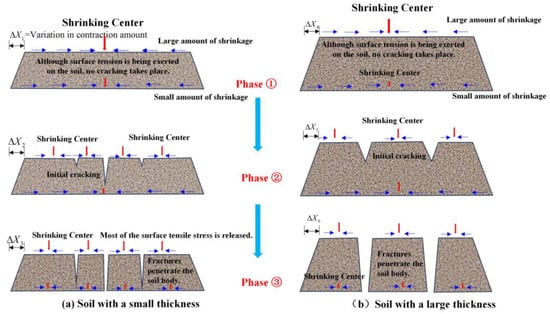
Figure 13.
Schematic diagram of crack evolution process in different thicknesses of expansive soil samples.
Existing studies have demonstrated that environmental factors [23] and the level of sectional friction caused by bottom constraint [24] influence the swelling and shrinkage deformation of expansive soil. In this experiment, we rigorously controlled these factors to investigate their impact on the cracking of expansive soil. To minimize the influence of bottom constraint on crack development, stainless steel trays were utilized as containers. These trays have highly smooth bottom surfaces, resulting in minimal frictional force. Based on the volume shrinkage characteristics of the specimens, the overall crack development in expansive soil can be categorized into three stages (see Figure 13). It is noteworthy that the location of the shrinkage center varies among specimens in different stages. Additionally, differences in the shrinkage (different thicknesses represented by Figure 9) before cracking in the expansive soil specimens become evident, and are influenced by the thickness of the specimen, with greater thickness corresponding to more significant shrinkage differences before cracking (ΔX4 > ΔX1). In the second stage, preliminary cracking occurs in the soil, thereby alleviating the tensile stress present in the surface soil layers. Consequently, the shrinkage amounts of specimens with different thicknesses gradually converge (ΔX5 > ΔX2). Thinner specimens tend to generate a greater number of cracks during initial cracking, which in turn leads to changes in the location of the shrinkage center. In the third stage, once cracking advances to stage three, the cracks have essentially interconnected. In thicker expansive soil specimens, the crack openings are wider but fewer in number, whereas in thinner specimens, the crack openings are narrower but more abundant. Notably, the development of cracks dissipates the tensile stress on the soil surface, resulting in a convergence of the shrinkage differences between the upper and lower parts of the soil. Consequently, a certain degree of shrinkage is observed in both the vertical and horizontal directions of the soil, resulting in a smaller volume of soil in the third stage when compared to the second stage. At this point, the evolution of cracks in the expansive soil essentially concludes.
6. Conclusions
This study analyzes the development characteristics of cracks in specimens of expansive soil under the influence of wet–dry cycles. The analysis is conducted through indoor tests on expansive soil and direct shear tests. It examines the evolution of cracks and the response of shear strength indicators of expansive soil to various factors, both quantitatively and qualitatively. The objective is to reveal the mechanism behind crack evolution in specimens of expansive soil. The main findings are as follows:
(1) The evolution of cracks in expansive soil exhibits an initial increase followed by stabilization with increasing wet–dry cycles, a phenomenon more pronounced in highly expansive soils. As cycles progress, the tensile forces from the surrounding soil drive lateral crack expansion, with average width increments of 0.5 mm for moderately expansive and 0.8 mm for highly expansive soil samples;
(2) The influence of initial moisture content on the crack ratio of expansive soil is intimately linked to its expansive properties. In moderately expansive soils, this influence diminishes with additional wet–dry cycles. In contrast, pronounced swelling and shrinkage are observed only in highly expansive soil samples with an initial moisture content exceeding 35%;
(3) Compaction significantly affects the crack count and length in expansive soils. At 90% compaction, the numbers of cracks in moderately and highly expansive soil samples drop by 71.4% and 68.8%, respectively, compared to those at 80% compaction, with a roughly 50% reduction in total crack length. Yet, as the sample height changes, the soil’s expansion and contraction behavior during wetting and drying becomes more intricate, with an overall reduction in crack count and length but an increase in crack density and average width.
(4) The shear strength of expansive soil is highly sensitive to wet–dry cycling. The cohesion of samples with an initial moisture content of 35% declines from 41.2 kPa to 20.3 kPa as the cycle count escalates, while the angle of internal friction fluctuates with an overall downward trend. The development of cracks under wet–dry cycling is identified as the cause of strength degradation, which correlates linearly with the crack ratio (R2>0.91).
Author Contributions
Conceptualization, Y.Z.; methodology, Y.Z.; validation, H.Z.; data curation, Y.Y. and M.O.; writing—original draft preparation, Y.Z.; writing—review and editing, Y.Z.; supervision, G.W.; funding acquisition, G.W. All authors have read and agreed to the published version of the manuscript.
Funding
The work described in this paper was fully supported by a grant from the Title of the Excellent Young Scientist Project for Scientific Research from the Education Department of Hunan Province in 2023 (Project Number: 23B1040), National Key Research and Development Program Project (Project Number: 2019YFC1509800), List of Key Technological Projects in the Transportation Industry, Ministry of Transportation, Year 2022 (Reference Number: 2022-MS5-125), and the Guangxi Key Research and Development Plan (Reference Number: AB23075184).
Institutional Review Board Statement
Not applicable.
Informed Consent Statement
Not applicable.
Data Availability Statement
The data that support the findings of this study are available from the corresponding author upon reasonable request.
Conflicts of Interest
Author Hongri Zhang was employed by the company Guangxi Transportation Science and Technology Group Co., Ltd. The remaining authors declare that the research was conducted in the absence of any commercial or financial relationships that could be construed as a potential conflict of interest.
References
- Guo, Y.; Chen, W.; Zhao, H. Experimental study on the water absorption process of expansive soil. Hydrogeol. Eng. Geol. 2016, 43, 108–112. [Google Scholar]
- Xia, D.; Liu, Q.; Xiang, W.; Wang, J.; Ai, M. Experimental study on the influence of montmorillonite content on shrinkage crack of clay surface. J. Yangtze River Sci. Res. Inst. 2016, 33, 83–86. [Google Scholar]
- Tong, C.; Yang, H.; Pedarlaa, A.; Hoyos, L.; Chittoori, B. Evaluating the expansion bsehavior of expansive soils based on specific surface area and pore size distribution. J. China Foreign Highw. 2017, 37, 209–215. [Google Scholar]
- Wang, X.; Yao, Z.; Dang, F.; Dong, z. Experimental study on microscopic structure evolution of fracture expansive soil. Trans. Chin. Soc. Agric. Eng. 2016, 32, 92–100. [Google Scholar]
- Xu, X.; Zhou, W.; Chen, S. Analysis of characteristics and influencing factors of crack opening and cracking process of reconstituted expansive soil in Nanyang. Rock Soil Mech. 2015, 36, 2569–2575. [Google Scholar]
- Xu, G.; Wang, G.; Gu, X.; Zeng, J. Experimental study on rainwater infiltration and stability of slopes with expansive soils. Chin. J. Geotech. Eng. 2006, 28, 270–273. [Google Scholar]
- Dai, Z.; Guo, J.; Luo, H.; Li, J.; Chen, S. Strength characteristics and slope stability analysis of expansive soil with filled fissures. Appl. Sci. 2020, 10, 4616. [Google Scholar] [CrossRef]
- Shi, B.X.; Chen, S.S.; Han, H.Q.; Zheng, C.-F. Expansive soil crack depth under cumulative damage. Sci. World J. 2014, 2014, 498437. [Google Scholar]
- Huang, Z.; Sun, H.Y.; Dai, Y.M.; Hou, P.-B.; Zhou, W.-Z.; Bian, L.-L. A study on the shear strength and dry-wet cracking behaviour of waste fibre-reinforced expansive soil. Case Stud. Constr. Mater. 2022, 16, e01142. [Google Scholar] [CrossRef]
- Hu, D.; Li, X.; Zhou, C.; Xue, L.; Liu, H. Quantitative analysis of cracks and swell-shrink behavior of expansive soils under Dry-Wet cycling. Rock Soil Mech. 2018, 39, 318–324. [Google Scholar]
- Gao, H.; An, R. Evolution characteristics of meso-cracks in expansive soil under desiccating conditions. Rock Soil Mech. 2023, 44, 7. [Google Scholar]
- Dai, Z.; Guo, J.; Zhong, K.; Tong, K.; Li, S.; Huang, K.; Chen, S. Dynamic evolution of three-dimensional cracks in expansive soil under wet-dry cycles: Insights from resistivity monitoring. Bull. Eng. Geol. Environ. 2024, 83, 305. [Google Scholar] [CrossRef]
- Guo, J.; Ding, G.; Wang, H. Dynamic development law of expansive soil cracks under environmental influence. Int. J. Civ. Eng. 2024, 22, 787–800. [Google Scholar] [CrossRef]
- Wei, B.; Huang, Z.; Gao, B.; Zhu, H. Evolution of cracks in expansive soils under dry-wet cycling and its influence on shear strength. Highw. Eng. 2015, 40, 127–130. [Google Scholar]
- Zhang, J.; Gong, B.; Hu, B.; Zhou, X.; Wang, J. Experimental study on evolution of cracks in expansive soils under Dry-Wet cycling. Rock Soil Mech. 2011, 32, 2729–2734. [Google Scholar]
- Chen, K. Evolutionary regularity of cracks in red clay slopes under Dry-Wet cycling. J. Build. Sci. Eng. 2019, 36, 52–61. [Google Scholar]
- Guo, J.; Ding, G.; Wang, H.; Li, S.; Dai, Z. Study on the dynamic development law of fissure in expansive soil under different soil thickness. Arch. Civ. Eng. 2023, 69, 519–534. [Google Scholar]
- Gao, H.; An, R.; Zhang, X.; Wang, G.; Liu, X.; Xu, Y. Dynamic evolution of desiccation cracks and their relationship with the hydraulic properties of expansive soil. Int. J. Geomech. 2024, 24, 04023299. [Google Scholar] [CrossRef]
- Ferreira, S.R.D.M.; Araújo, A.G.D.D.; Barbosa, F.A.S.; Silva, T.C.R.; Bezerra, I.M.d.L. Analysis of changes in volume and propagation of cracks in expansive soil due to changes in water content. Rev. Bras. Ciênc. Solo 2020, 44, e0190169. [Google Scholar] [CrossRef]
- Zhao, G.T.; Zou, W.L.; Han, Z.; Wang, D.-X.; Wang, X.-Q. Evolution of soil-water and shrinkage characteristics of an expansive clay during freeze-thaw and drying-wetting cycles. Cold Reg. Sci. Technol. 2021, 186, 103275. [Google Scholar] [CrossRef]
- Zhang, H.; Yang, J.; Wang, L.; Xu, Y. Model test on the dynamic characteristics of crack formation in expansive soil slopes under alternate drying and wetting. Acta Geotech. 2023, 18, 2097–2115. [Google Scholar] [CrossRef]
- Zhu, H.; Zhang, Y.; Li, Z.; Xue, X. Study on crack development and micro-pore mechanism of expansive soil improved by coal gangue under drying–wetting cycles. Materials 2021, 14, 6546. [Google Scholar] [CrossRef]
- Liu, J.; Yu, J.; Hu, S.; Hu, C.-L.; Wang, J.-J.; Yu, Z.-W.; Huang, K. Analysis of crack evolution of expansive soil embankment under extreme arid climate. Case Stud. Constr. Mater. 2024, 20, e02902. [Google Scholar] [CrossRef]
- Ministry of Water Resources of the People’s Republic of China. Geotechnical Testing Methods Standard; China Planning Press: Beijing, China, 2019.
- Tang, C.; Cui, Y.; Tang, A.M.; Shi, B. Shrinkage crack process and its temperature effect of expansive soil. Chin. J. Geotech. Eng. 2012, 34, 2181–2187. [Google Scholar]
- Zeng, H.; Tang, C.; Liu, C.; Lin, N.; Xu, J. Test and analysis of shrinkage stress in the drying process of expansive soils. Chin. J. Geotech. Eng. 2019, 41, 717–725. [Google Scholar]
- Liu, G.; Chen, Y.; Zeng, X.; Zhang, G. Experimental study on the influence of environmental humidity and temperature on crack development of compacted expansive soil. Chin. J. Geotech. Eng. 2020, 42, 260–268. [Google Scholar]
- Uday, K.V.; Singh, D.N. Investigation on cracking characteristics of fine-grained soils under varied environmental conditions. Dry. Technol. 2013, 31, 1255–1266. [Google Scholar] [CrossRef]
Disclaimer/Publisher’s Note: The statements, opinions and data contained in all publications are solely those of the individual author(s) and contributor(s) and not of MDPI and/or the editor(s). MDPI and/or the editor(s) disclaim responsibility for any injury to people or property resulting from any ideas, methods, instructions or products referred to in the content. |
© 2024 by the authors. Licensee MDPI, Basel, Switzerland. This article is an open access article distributed under the terms and conditions of the Creative Commons Attribution (CC BY) license (https://creativecommons.org/licenses/by/4.0/).